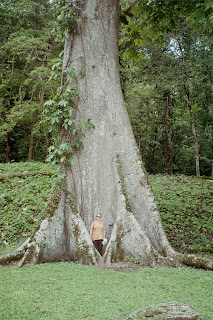 Imagine this: Thousands of butterflies—orange, white, blue, brown, red, and yellow—flitting around you as you cruise down a swift river in a kayak-like wooden boat. Beyond the palm roof of your lancha, you can see jungle, thick, sweaty, and alive. There are vines, palms, banana trees, and giant tree trunks oozing ancient Mayan bubble gum. Monkeys lounging in trees, monkeys howling and grunting in the distance. Bromeliads hang in fuschia splendor from a towering ceiba tree; yellow and purple orchids float on a draft of wind down to the river. And as a soundtrack to it all, birds twitter and sing while cicadas and tree frogs add an incessant bass rhythm.
Imagine this: Thousands of butterflies—orange, white, blue, brown, red, and yellow—flitting around you as you cruise down a swift river in a kayak-like wooden boat. Beyond the palm roof of your lancha, you can see jungle, thick, sweaty, and alive. There are vines, palms, banana trees, and giant tree trunks oozing ancient Mayan bubble gum. Monkeys lounging in trees, monkeys howling and grunting in the distance. Bromeliads hang in fuschia splendor from a towering ceiba tree; yellow and purple orchids float on a draft of wind down to the river. And as a soundtrack to it all, birds twitter and sing while cicadas and tree frogs add an incessant bass rhythm.This is the Central American jungle, and we've been immersed in it for over a week now. After two weeks in the temperate highlands of central Mexico, we made the plunge into jungle humidity. Despite a sweaty first day where glasses fogged so much it was futile to wear them, I've been surprised and delighted by the treasures this jungle (the largest contiguous rainforest in North and Central America) holds.
In Mexico, the jungle is a shelter. It hides ancient Mayan ruins, Zapatista rebels, even jaguars. We've been fortunate enough to see many of the first, but the latter two have eluded us. That's okay, though, because other hidden treasures have been quick in coming. In Palenque, the real treasure was the jungle hamlet of El Panchan, a backpacker's haunt. We stayed in a
 palapa-thatched hut and spent our non-tourist hours relaxing at Don Mucho's. Don Mucho appears to be a transplanted Florida biker dude who has set up a dining and drinking establishment that would do Cocktail proud. Beers are cheap, pizza satisfies the tortilla-weary, and nightly entertainment includes live Latin bands and fire dancers. What's more, two hundred some travelers—otherwise lost in the jungle—congregate there each night to meet kindred spirits. Imagine a dinner conversation haltingly jumping from French to Spanish to German to English...and everybody leaves thinking they just met the coolest people on Earth. That's Don Mucho's for you.
palapa-thatched hut and spent our non-tourist hours relaxing at Don Mucho's. Don Mucho appears to be a transplanted Florida biker dude who has set up a dining and drinking establishment that would do Cocktail proud. Beers are cheap, pizza satisfies the tortilla-weary, and nightly entertainment includes live Latin bands and fire dancers. What's more, two hundred some travelers—otherwise lost in the jungle—congregate there each night to meet kindred spirits. Imagine a dinner conversation haltingly jumping from French to Spanish to German to English...and everybody leaves thinking they just met the coolest people on Earth. That's Don Mucho's for you.There have been other jungle treasures. In the heart of Chiapas, we stayed with a Lacondon Maya family, teaching their son to play frisbee, entertaining their toddler with Spanglish games of make-believe, and partaking in home-cooked feasts with international guests. As we moved on from Mexico, the border with Guatemala was itself a surprise. The Usumacinta River forms the border between the two countries in the rainforest, and to cross it you must board a tiny wooden boat that dodges currents and crocodiles to reach the muddy border town of Bethel, Guatemala. In Bethel you find an immigration office, french fries, money changers, and a rickety old bus that will cart you down four hours of unpaved roads to get you to the next jungle destination: Tikal. Although this largest of ancient Mayan cities is indeed amazing (we spent over an hour sitting atop a 200-foot temple, just soaking in the jungle, the very same spot where George Lucas filmed the skyscape of the rebel planet in the original Star Wars), it's the tiny town of El Remate that has really won us over. El Remate sits on a spring-fed lake, crystalline and aqua in color, and is surrounded by densely green hills. In the forest, spider monkeys will inquisitively seek you out (although it's the howler monkeys that sound like Godzilla); in the lake, you can test your birding knowledge identifying kingfishers, orioles, egrets, even parrots. In town, Don David—another Florida transplant, although this one is nearly 80 years old—has set up a deceptively bug-free oasis where we've been hanging our hats. An eager guide to all things Remate, he took us on a moonlight tour of his gardens last night. It included night-blooming cactus flowers and a fist-size resident tarantula, who Don David lets roam all over himself. Good thing the rooms are well-screened.
But then again, what would a jungle sojourn be without a little adrenalized fun? As if climbing moss-covered, mountain-sized temples weren't enough, we've gone on zip-line canopy tours, sought out crocodiles in local swamps, and tried a rainforest hike in the rain. The adventuresome spirit has been well-rewarded, mostly with wildlife. The highlights: a toucan, a few feet below me, feasting on little jungle berries; a tiny little mouse that hops; a lizard with a foot-long tail that runs on it´s back two legs only; and kippimundis, racoon-like critters that look straight out of a Dr. Seuss book. We must be on to a good thing: CBS's Survivor has set up shop just a few miles away.
This jungle of butterflies and orchids, palms and full-moon nights, is delightful. We'll say goodbye to it in Belize, where we head tomorrow.





